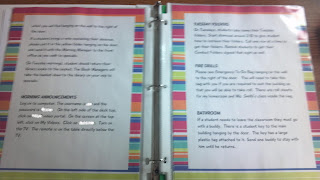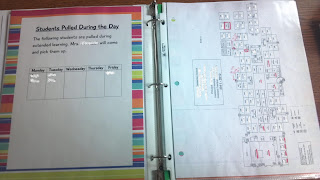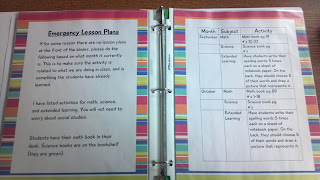First of all, I just want to say that my DonorsChoose project (digital microscope) has been fully funded! I'm so beyond excited and grateful to my donors. Thank you!
Now, moving on to textbooks.
When I taught 5th grade science and language arts, I did not have my students check out their own textbook. We just didn't use them enough for it to be worth it. Really, the only reason I had them for for a quick and easy activity when I had a sub. I checked out a class set of textbooks that I kept in my room just to use as needed.
This year, in fourth grade, we still don't use the books a whole lot. I have a class set of science books, but the students have checked out their own social studies and math books. Looking back, I would have preferred a class set of social studies, but I went with the preference of the team.
To try to keep desks neater, my students keep only their math book in their desk. I have collected their social studies books to keep on the bookshelf with the science books. I have two "book managers" to pass out the books when we need them.
I switch classes with another teacher. It's pointless for those students to carry a huge textbook back and forth everyday, when we only use them once or twice a month.
To let my students in my switch class know if they need to bring their math book or not, I post a sign on my door. I actually got this from a 5th grade math co-worker, and it works well. On one side of the sign it says "No math book" and on the other side it says "Bring math book today." In the morning as students arrive, the sign is posted on my door letting them know. They're learning to take responsibility, and I don't have to interrupt my partner's class (or even remember to!) to let the kids know to bring their book.
Wednesday, February 29, 2012
Tuesday, February 28, 2012
Donors Choose
Donors Choose is a wonderful philanthropic website that allows teachers to post projects they need funded. The requests vary from basic school supplies to technology to field trips.
My first project was posted this morning. I am trying to fund a digital microscope to use in the classroom next year (or even this year if it gets funded in time!).
Some companies will match donations, making it easier to get the funding you need. You don't have to apply separately for this - the companies let Donors Choose know the type of projects they'd like to fund, and if your project meets their criteria, then it automatically applies the "Double Your Impact" offer. I am lucky that the ECA Foundation is able to match donations made to my project.
Hopefully we'll be able to get the $92 needed to fund my project. If you know of anyone able to make a tax deductible donation, I'd appreciate you passing my project along!
My first project was posted this morning. I am trying to fund a digital microscope to use in the classroom next year (or even this year if it gets funded in time!).
Some companies will match donations, making it easier to get the funding you need. You don't have to apply separately for this - the companies let Donors Choose know the type of projects they'd like to fund, and if your project meets their criteria, then it automatically applies the "Double Your Impact" offer. I am lucky that the ECA Foundation is able to match donations made to my project.
Hopefully we'll be able to get the $92 needed to fund my project. If you know of anyone able to make a tax deductible donation, I'd appreciate you passing my project along!
Monday, February 27, 2012
Sub Binders
Since I will be out tomorrow for a dentist appointment, I figured this would be a good time to post about my sub binder. If there is one organizational thing that I'm proud of, it's my sub binder. Let's face it - subs have a tough enough time as it is without going into a classroom where they don't know the daily procedures and expectations. So I try to make it as easy and painless as possible for my guest teachers.
I also have a form that I leave for the subs where they can leave notes for me and tell me about their day.
This is a link to get to my sub binder word document. As with the sub plan template, I took out some identifying information for privacy's sake, which is marked in red.
Yup, I'm proud. :)
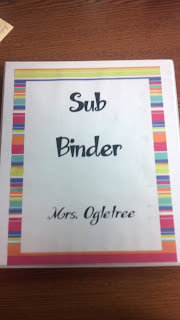 |
| I keep my sub binder on the chalkboard near my desk so it's visible in case of an emergency. My kids also know where it is. When I know I'm prepping my room for a sub, I put it on my desk. |
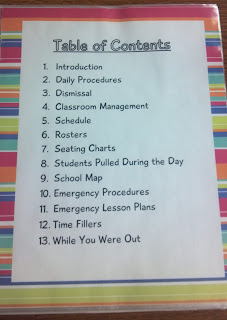 |
| I recently made my binder nice and colorful. |
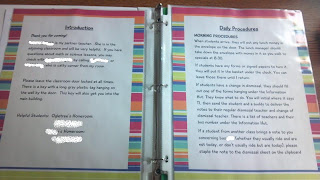 | |
| My intro is just a welcome with basic information such as which teachers can help with lessons, and which students are helpful. After that starts my daily procedures. |
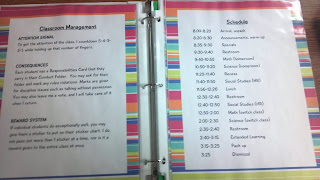 |
| My Classroom Management page explain my attention signal, rewards, and consequences. I also have a quick run-down of the daily schedule. |
 |
| Emergency procedures for fire drills, etc. |
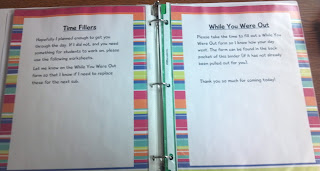 |
| At the back of the binder I have time fillers such as word searches just in case my class finishes their work early. |
I also have a form that I leave for the subs where they can leave notes for me and tell me about their day.
This is a link to get to my sub binder word document. As with the sub plan template, I took out some identifying information for privacy's sake, which is marked in red.
Yup, I'm proud. :)
Saturday, February 25, 2012
Dollar Store Finds!
I wasn't planning on shopping today, but when I drove by the dollar store near my house, I saw that they were going out of business and everything was $0.19, so I absolutely had to stop. I love a deal! I could have gone crazy in that store, but I decided to behave myself. I bought only things for my classroom, and I only got things that I had a use for - I did not buy things on the chance that I may find a use for them later on (I do that sometimes too). I got all these goodies for less than $5.
I felt like I won the lottery. :)
If I didn't have somewhere I needed to be, I'd have walked through the store a second time to see what I could come up with.
I felt like I won the lottery. :)
 |
| Stickers. |
 |
| Pencil grips to use as a reward. |
 |
| Can always use magnets. |
 |
| I think I ended up with about 20 containers total to organize my drawers. |
 |
| Six place mats. Now this one I don't have an exact idea for, but I'll be putting paper on them and having the flowers as the border. I just don't know exactly what papers will go on them yet. |
 |
| This is a makeup case I'll be using for paperclips, push pins, etc. |
Vocab Display
My classroom this year is in a portable, and I don't have a lot of wall space which makes it difficult to post vocabulary cards. I actually got this idea from another teacher, but I used gallon size ziploc bags and duct tape to make a vocabulary chart.
I put the top to bags up and down, which was perfect for my metric and customary cards. The other four I put on sideways, making sure I didn't tape over the opening for changing out cards. The gallon size bags are the perfect size for our cards. And there's all kinds of colorful tape out there to make it pretty, or make it fit your theme. I change the vocabulary daily based on what is on the warm up for that day.
I put the top to bags up and down, which was perfect for my metric and customary cards. The other four I put on sideways, making sure I didn't tape over the opening for changing out cards. The gallon size bags are the perfect size for our cards. And there's all kinds of colorful tape out there to make it pretty, or make it fit your theme. I change the vocabulary daily based on what is on the warm up for that day.
Thursday, February 23, 2012
CHAMPS
CHAMPS is a classroom management technique used at my school. It sets expectations for students for various activities. CHAMPS stand for
So all I have to do is change the strip for that expectation.
The conversation level can be:
To get help, it may say
The activity might be
Movement options are
When students are done with their work, they will
Supplies lets students know if they are using
If a student asks if they are supposed to write in pen or pencil (this was for my 5th graders), I say, "What does CHAMPS say?"
After a while, they get the point. Sometimes they'll start to ask me, then turn around and look at the board, because they know that's what I'm going to tell them to do. :-)
Next to my CHAMPS board is a door where I tell students what they are allowed to do when they are finished with their work. I printed out signs, laminated them, and put magnetic tape on the back. It makes it easy to switch out options.
These are my go-to activities that are almost always up. Sometimes, though, I take down VersaTiles depending on how quiet I want to keep it, such as for tests. Other things I may put up are Beat The Clock (to practice math facts), flash cards, acrostic poems (I give them a word), ABC lists (I give them a topic), and probably some others I can't think of right now. My kids know that drawing is never an option, though they sometimes like to see if I've forgotten my own rule.
Now I'm Done is a drawer where I put fun (and usually educational) worksheets. It may have math problems (line designs are popular, and the ones where you solve the problem to determine what color you shade a piece in - I don't remember what they're called), creative writing, using dictionaries, patterns, word searches, etc. Basically, whatever I can find. I don't give bonus points; I don't even check them. Students turn them in to the inbox so I can see what they've done, then I send them right back home with them.
I changed it up a little bit for my own classroom. For my class, CHAMPS set expectations forConversation: Can students talk to each other during this activity?
Help: How do students get the teacher's attention and their questions answered?
Activity: What is the task/objective? What is the end product?
Movement: Can students move about during this activity?
Participation: How do students show they are fully participating? What does work behavior look/sound like?
Success: When students meet CHAMPS expectations, they will be successful!
ConversationI have a CHAMPS board on display in my room. Prior to each activity, I explain the expectations and update the CHAMPS board. Because I do this regularly, my students will remind me if I forget. It really helps them to have a visual reminder.
Help
Activity
Movement
Post-Activity (What should students do with their assignment when they are finished?)
Supplies (What supplies are needed for this activity?)
 |
| Jealous of my ugly brown paneling? Of course you are... |
So all I have to do is change the strip for that expectation.
The conversation level can be:
- No Talking
- Whisper
- Low Voices
To get help, it may say
- Ask group then raise hand
- Raise hand
- Kidney Table (which is where students go for small groups)
The activity might be
- Individual work
- Group work
- Partners
- Lab
- Test / Quiz
Movement options are
- Stay in your seat
- Stay in your group
- Trashcan and pencil sharpener
- Move around
When students are done with their work, they will
- Keep it
- Turn it in to the Inbox
- Other (I may have some other place I want them to put their work)
Supplies lets students know if they are using
- Pen
- Pencil
- Red Pen
- Supply Boxes (markers, color pencils, etc)
- Glue / Scissors
- Book
- Journal
If a student asks if they are supposed to write in pen or pencil (this was for my 5th graders), I say, "What does CHAMPS say?"
After a while, they get the point. Sometimes they'll start to ask me, then turn around and look at the board, because they know that's what I'm going to tell them to do. :-)
Next to my CHAMPS board is a door where I tell students what they are allowed to do when they are finished with their work. I printed out signs, laminated them, and put magnetic tape on the back. It makes it easy to switch out options.
These are my go-to activities that are almost always up. Sometimes, though, I take down VersaTiles depending on how quiet I want to keep it, such as for tests. Other things I may put up are Beat The Clock (to practice math facts), flash cards, acrostic poems (I give them a word), ABC lists (I give them a topic), and probably some others I can't think of right now. My kids know that drawing is never an option, though they sometimes like to see if I've forgotten my own rule.
Now I'm Done is a drawer where I put fun (and usually educational) worksheets. It may have math problems (line designs are popular, and the ones where you solve the problem to determine what color you shade a piece in - I don't remember what they're called), creative writing, using dictionaries, patterns, word searches, etc. Basically, whatever I can find. I don't give bonus points; I don't even check them. Students turn them in to the inbox so I can see what they've done, then I send them right back home with them.
Wednesday, February 22, 2012
Class Dojo
When I have a difficult class, I'm willing to try almost anything to maintain a productive atmosphere. ClassDojo is one of the things I tried, and it has worked pretty well with my kids.
Once you sign up, you'll create your classes. Since I have two classes, I titled them "homeroom" and "switch class". I know, super creative. In each class, you'll have to input your kids' names. Dojo (as me and my students call it) will randomly assign avatars to each child.
After I put in my students, I changed the positive and negative behaviors to those that work for me.
I don't use it every day because I don't want my kids to get bored with it. I like to change things up to keep it fresh sometimes. When I do use it, I'll either project it on the SmartBoard or on my TV. Apparently you can also use this on your phone while walking around the room and in the halls, but I haven't tried it.
To make it worth their while, the person with the most positives at the end of the day (or sometimes end of the week) will get some kind of reward like a homework pass or a pencil. Students who end up with 3 negatives at the end of the day get a "mark" on their Responsibility Card.
The kids enjoy it, and it provides a little incentive/reminder to stay on task.
Once you sign up, you'll create your classes. Since I have two classes, I titled them "homeroom" and "switch class". I know, super creative. In each class, you'll have to input your kids' names. Dojo (as me and my students call it) will randomly assign avatars to each child.
After I put in my students, I changed the positive and negative behaviors to those that work for me.
I don't use it every day because I don't want my kids to get bored with it. I like to change things up to keep it fresh sometimes. When I do use it, I'll either project it on the SmartBoard or on my TV. Apparently you can also use this on your phone while walking around the room and in the halls, but I haven't tried it.
To make it worth their while, the person with the most positives at the end of the day (or sometimes end of the week) will get some kind of reward like a homework pass or a pencil. Students who end up with 3 negatives at the end of the day get a "mark" on their Responsibility Card.
The kids enjoy it, and it provides a little incentive/reminder to stay on task.
Exemplars Math
This year, my district is encouraging math teachers to use Exemplars in the classroom. Exemplars consists of one real world related problem that students solve individually, in pairs, or in groups. Not only do students have to find the answer, but the whole idea behind Exemplars is that students prove what they know.
Without me getting into too much detail, I'll try to explain how I use Exemplars in my classroom. My grade level as a whole does one Exemplar each 6 weeks. I spend about 2 hours on it, spread out over 2-3 days. I require my students to use the district problem solving method to help them organize their work. This is a document I made that I show my kids on the SmartBoard whenever we do Exemplars to remind them what goes in each section.
The first day, I have students work on the problem on their own. They are required to make the problem solving chart I linked to above. Since writing is a big part of fourth grade with the state test and all that, I do require my students to write in complete sentences. It's a good habit to get in. :)
The next day, I put students in groups to discuss the problem. They'll make any corrections necessary, then put their answer on butcher paper using the same problem solving method. I assign groups, putting between 3-4 students in each group. I try to include one high and one low in each group, while balancing out any discipline concerns. I make different groups each time we do Exemplars.
The students really enjoy this activity, and usually do a good job with their posters. I encourage them to go into as much detail as possible. Some students are better at this than others.
The problem we are currently working on asks how many speeds a bike has if there are 3 gears on one handle and 7 gears on the other. Below are some examples of their work from today.
As students turned in their posters, I read over then to determine the "best". The "best", as I told my students, is the poster with the most detail and that does the best job explaining their strategy and answer. I gave the winners from each of my two classes a pass to not wear shoes in class for a day. It's free, and they were so excited about it.
We're going to spend one more day on Exemplars for this grading period. Tomorrow, I'm having my students do a gallery walk to evaluate the posters, both what was done well, and what needs improvement. Instead of having them look at all the posters (after all, they all say pretty much the same thing), I'm assigning each student to 4 posters. I picked out the two with the best explanations, and all of my students will be required to evaluate one of them so that they can see what a really good poster looks like.
Without me getting into too much detail, I'll try to explain how I use Exemplars in my classroom. My grade level as a whole does one Exemplar each 6 weeks. I spend about 2 hours on it, spread out over 2-3 days. I require my students to use the district problem solving method to help them organize their work. This is a document I made that I show my kids on the SmartBoard whenever we do Exemplars to remind them what goes in each section.
The first day, I have students work on the problem on their own. They are required to make the problem solving chart I linked to above. Since writing is a big part of fourth grade with the state test and all that, I do require my students to write in complete sentences. It's a good habit to get in. :)
The next day, I put students in groups to discuss the problem. They'll make any corrections necessary, then put their answer on butcher paper using the same problem solving method. I assign groups, putting between 3-4 students in each group. I try to include one high and one low in each group, while balancing out any discipline concerns. I make different groups each time we do Exemplars.
The students really enjoy this activity, and usually do a good job with their posters. I encourage them to go into as much detail as possible. Some students are better at this than others.
The problem we are currently working on asks how many speeds a bike has if there are 3 gears on one handle and 7 gears on the other. Below are some examples of their work from today.
As students turned in their posters, I read over then to determine the "best". The "best", as I told my students, is the poster with the most detail and that does the best job explaining their strategy and answer. I gave the winners from each of my two classes a pass to not wear shoes in class for a day. It's free, and they were so excited about it.
We're going to spend one more day on Exemplars for this grading period. Tomorrow, I'm having my students do a gallery walk to evaluate the posters, both what was done well, and what needs improvement. Instead of having them look at all the posters (after all, they all say pretty much the same thing), I'm assigning each student to 4 posters. I picked out the two with the best explanations, and all of my students will be required to evaluate one of them so that they can see what a really good poster looks like.
Tuesday, February 21, 2012
My First Post!
After browsing Pinterest and all the awesome blogs out there, I caved in and decided to start my own. It is what all the cool kids are doing, right?
I'm in my fourth year of teaching. In that time, I've taught 4th, 5th, 6th, and 8th grade; science, math, social studies, and language arts. I'm currently teaching 4th grade math, science, and social studies.
I like to think I'm organized. Now, I'm nothing compared to the organization gurus out there, flaunting their perfect classrooms. My box Kleenex is out of place sometimes. I've got science supplies scattered on the floor around my desk as I prepare lessons for the other teachers. But I'm trying to get better. Like any teacher, I would love a perfectly organized classroom. And in August, my room looks amazing. But then the kids come. Then we start learning things, and doing experiments, and having fun, and learning life lessons. So as they say, "Pardon the mess. The children are making memories." Indeed.
I also don't make all my own worksheets and activities. Why reinvent the wheel when that wheel over there works just fine? I'll make some of my own, and those I'll post here to share. What I do love to do, though, is make PowerPoints and SmartBoard lessons. I would even go so far as to say that would by my niche. I love incorporating technology into my classroom. Of course I'm not as good as a lot of bloggers out there, but I'm trying, and I'm learning, and I'm getting better.
So, what is my blog going to consist of? I don't really know. Perhaps organizational ideas. Lesson ideas. Experiments. Classroom management techniques. Technology. Worksheets. A soapbox to vent all my daily frustrations. I'll just be going with the flow, posting whatever comes to mind, and pretend it's on the lesson plan. I am getting pretty good at that. :-)
I'm in my fourth year of teaching. In that time, I've taught 4th, 5th, 6th, and 8th grade; science, math, social studies, and language arts. I'm currently teaching 4th grade math, science, and social studies.
I like to think I'm organized. Now, I'm nothing compared to the organization gurus out there, flaunting their perfect classrooms. My box Kleenex is out of place sometimes. I've got science supplies scattered on the floor around my desk as I prepare lessons for the other teachers. But I'm trying to get better. Like any teacher, I would love a perfectly organized classroom. And in August, my room looks amazing. But then the kids come. Then we start learning things, and doing experiments, and having fun, and learning life lessons. So as they say, "Pardon the mess. The children are making memories." Indeed.
I also don't make all my own worksheets and activities. Why reinvent the wheel when that wheel over there works just fine? I'll make some of my own, and those I'll post here to share. What I do love to do, though, is make PowerPoints and SmartBoard lessons. I would even go so far as to say that would by my niche. I love incorporating technology into my classroom. Of course I'm not as good as a lot of bloggers out there, but I'm trying, and I'm learning, and I'm getting better.
So, what is my blog going to consist of? I don't really know. Perhaps organizational ideas. Lesson ideas. Experiments. Classroom management techniques. Technology. Worksheets. A soapbox to vent all my daily frustrations. I'll just be going with the flow, posting whatever comes to mind, and pretend it's on the lesson plan. I am getting pretty good at that. :-)
Subscribe to:
Comments (Atom)





